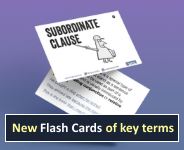Topic: Direct Object
These resources relate to the grammatical function Direct Object. The Direct Object is needed to complete the meaning of some verbs, and often expresses who or what has an action done to them, e.g. the baby in Joe tickled the baby. But this is not always true, so these resources look at typical grammatical properties which distinguish Direct Objects, like their position after the verb phrase.
Englicious contains many resources for English language in schools, but the vast majority of them require you to register and log in first. For more information, see What is Englicious?

